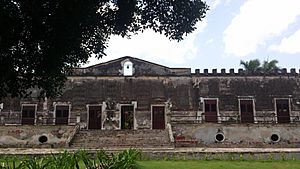Yaxcopoil facts for kids
Hacienda Yaxcopoil (say it: YASH-coh-poh-EEL) is a special place in Yucatán, Mexico, near the city of Mérida. It's a town and a big old estate called a hacienda. This hacienda has been around since the 1600s! Its name, Yaxcopoil, means "the place of the green alamo trees" in the Yucatec Maya language. You can still see one of these green alamo trees right in front of the hacienda.
This amazing place shows us the history of three big times in the Yucatán Peninsula. First, there's the ancient Maya period, with old ruins nearby. Then, there's the time when the Spanish came and settled. And finally, there was a time when a plant called henequen was grown a lot, which brought a lot of money to the area in the late 1800s and early 1900s.
In 1864, Don Donaciano García Rejón and his wife Doña Mónica Galera bought Hacienda Yaxcopoil. It has stayed in their family ever since.
Contents
A Very Large Estate
Hacienda Yaxcopoil was once one of the most important farms in Yucatán. It was huge! At its biggest, it covered about 22,000 acres (89 km2), which is a massive area.
First, the hacienda was a cattle ranch, raising cows. Later, it became a henequen plantation. Henequen is a plant used to make strong fibers for ropes and other things. Over many years, because of changes in politics, society, and money, the hacienda became much smaller. Now, it's less than 3% of its original size.
What's Inside the Hacienda?
Inside the main house, you can see many of the original pieces of furniture. There are also two old oil paintings of Don Donaciano García Rejón and his wife Doña Mónica Galera.
The office room is full of old books, maps, and important papers. These documents are part of Yaxcopoil's history. They have been kept very carefully and can be used by people who are doing research.
The Patron Saint and Water Supply
The special saint of the hacienda is San Gerónimo de Yaxcopoil. People in the nearby town still honor him.
In the hacienda's garden, there are old water tanks and a pump from the United States. This pump still works and supplies water to the hacienda today! Now, the hacienda is a museum and also a guest house where people can stay overnight.
The Maya Room
At the back of the museum, you'll find the "Maya Room." This room has many ancient pots and other cool things found in the nearby Maya ruins of Yaxcopoil. These items are from the "classic period" of Maya history, which was from about A.D. 250 to 900.
Around the hacienda, there are many unexcavated pyramids. These pyramids are different heights, from about six to twenty meters tall. There's also a court where the Maya played ceremonial ball games. You can also see stelae, which are tall stone monuments, spread out over a large area of about eight square kilometers.
The Old Machines
Hacienda Yaxcopoil also has a well-kept machine house, called a casa de maquina. This is where the henequen plants were processed. Big machines called planta desfibradora were used to shred the plants and get the fibers out.
The engine room is still in great condition. It has a huge 100 hp (75 kW) German diesel motor made by a company called Körting in 1913. This powerful engine was used until 1984. That's when the hacienda stopped making henequen fiber, after more than a hundred years of work!
Today, Hacienda Yaxcopoil has been kept as it was, without big changes or renovations. It works as a museum, so people can visit and learn about its history. It's also a popular spot for photo shoots and filming movies. And, as mentioned, you can even rent a guest house on the property for a unique overnight stay.
Chicxulub Crater Research
Yaxcopoil was an important place for science! In 2001 and 2002, a special project called the Chicxulub Scientific Drilling Project (CSDP) drilled a deep hole here, called Yaxcopoil-1.
A team of scientists from many countries drilled down 1511 meters into the ground. They did this to study the Chicxulub crater. This crater was made 66 million years ago when a huge meteor hit the Earth right here in the Yucatán Peninsula.
This was the first time scientists drilled so deep into one of the biggest and best-preserved impact craters on Earth. They used different methods to get samples and take measurements. This helped them understand more about how the meteor impact happened. The project cost $1.5 million USD and was led by UNAM, a big university in Mexico. The hole drilled at Yaxcopoil has also been used to test the freshwater underground water supply in Yucatán.
See also



